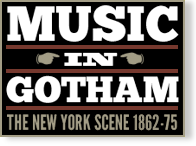Philharmonic Society of New York Public Rehearsal
Event Information
Venue(s):
Academy of Music
Conductor(s):
Carl Bergmann
Event Type:
Orchestral
Record Information
Status:
Published
Last Updated:
19 June 2025
Performance Date(s) and Time(s)
22 Jan 1875, 2:30 PMPerformers and/or Works Performed
Citations
“The third public rehearsal of the music to be performed to-night at the third concert of the Philharmonic Society was held yesterday afternoon at the Academy of Music. Haydn’s Symphony in C minor was played very smoothly. The ideas therein contained being set forth in the clearest, most lucid manner they may be fully comprehended at the first hearing. To those who had been accustomed to attend these concerts long before the music of the new German school found a place in the programmes, this symphony was probably more welcome than the rest of the orchestral music. The compositions of Haydn are not only immediately intelligible and perspicuous, but, like those of Mozart, breathe a spirit of contentment, peace of mind, and complete satisfaction, and also most frequently are cheerful and gay, light hearted and juvenescent. In this sense they are seen to differ from those of many later composers, some of whose works give evidence of ceaseless aspirations and constant strivings for the realization of an ideal which shall elevate them far above their present experiences. In this symphony, therefore, which is extremely beautiful and elevated in expression, there is no infelicity or inquietude, no heart-burning or despondency manifested. All longings, passionate hopes and painful upward stridings are unknown. Although two of the movements are in the minor key of C, the major breaks forth upon them bright and enlivening as the morning sun.
Bach’s ‘Ciaconna’ was played very slowly, but the grandeur and wealth of the harmonies were thus made more fully apparent, although, as we have already pointed out, this ‘reading’ is not in all respects to be considered advantageous.
The introduction to Wagner’s ‘Tristan und Isolde,’ though technically more correctly played than at the preceding rehearsals, still appeared wanting in finish and refinement as far as the details of the execution are concerned, and also seemed to want greater delicacy in respect to the volume of tone throughout. The texture of this exquisitely beautiful composition appears to require an almost fastidious performance, that its one effect may be obtained. It gains greatly by being played extremely soft, especially in the parts marked to be played softly, that other parts by being rendered only a little less soft may afford a contrast. Then the magnificent climax which is attained towards its close gains greatly in its power and influence over us. This grand orchestra is heard to much greater advantage in compositions of more masculine character. In dignified, stately, bold, majestic music—in movements of larger proportions and which require more massive and sublime effects, its enlarged stringed band in this vast buildingis capable of accomplishing much that is specially noteworthy. The performance of Schumann’s Rhenish symphony at the last concert might be quoted in support of this assertion. In accordance with the programmes of the celebrated Gewandhaus concerts in Leipzig, the long symphony is here found given as the last piece. The new work by Raff, of which we have already spoken at length, was played so well at the rehearsal that we anticipate a remarkable performance will be given to-night. The Scherzo was taken at full speed, but the Funeral March, which is marked by the composer to be played at eighty-four beats per minute, was performed at the uniform rate of seventy-five. The three trombones, all being slide instruments without valves or pistons, produce the most natural, and therefore most satisfactory tones. Their re-entry, with the principal theme of the march which Raff has happily planned, was one of the most prominent points of the whole composition.
Mrs. Henry Butman sang Mozart’s recitation and aria from ‘Don Giovanni’ and the favorite cavatina from ‘Bel Raggio’ from Rossini’s ‘Semiramide,’ with orchestral accompaniment, very nicely. Her voice is a full soprano, which is brilliant and strong in the upper notes; but the lower notes are not of uniformly good quality, though they are not at all unpleasant tones. Her executive abilities are much above the average of those who have attempted Rossini’s brilliant concert-like arias.”

